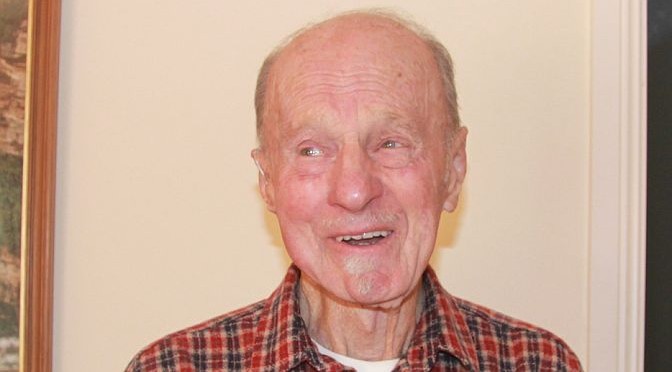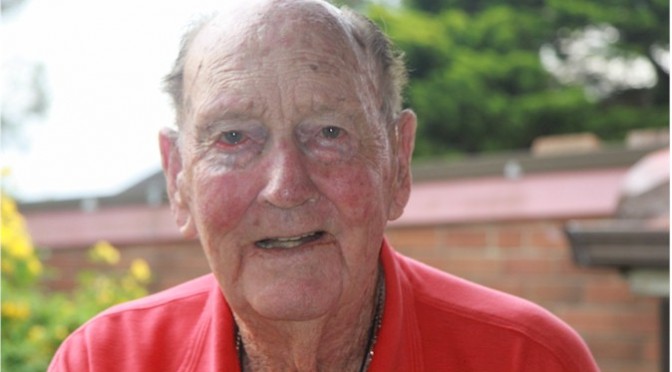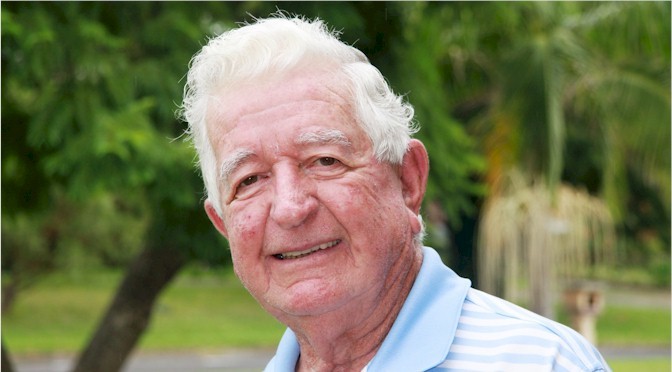| Project Name: Australian Golf Heritage Society Oral History Project | |
| For further information and a project brief, please contact: Curator/Collection Manager Australian Golf Heritage Society |
|
| Interview Length | 01:38:34 – edited 01:40:38 – archival |
| Interview Number | No.3 of series |
| Timed log | X |
| Name of interviewee | Edgar Oakman |
| Date of Birth | 28/08/1930 |
| Date of Interview | 22/4/2013 |
| Place of Interview | Interviewee’s home/Bowral, NSW Australia |
Technical Data – Sound Files
| Brand and Model of Digital Recorder | Zoom H4N |
| Brand and type of microphones used (with split cable adapter) |
Sony Condenser |
| Sound Storage Medium used – USB, CD – client | History Herstory has back-up copies |
| Location of Back-up | Home – various and Dropbox |
| Digital Recording Rate | Uncompressed WAV 24 bit 48 kHz archivalCD (WAV – 44.1/16) and MP3 – edited |
| Sound Field | Stereo |
Technical Data – Photographs/Images
| Full Title of each item | Edgar Oakman portraits |
| Place/location where photograph was taken | Bowral |
| Creator | Interviewer |
| Source Access/Restrictions/Copyright | Nil restrictions |
| Model of Digital Camera | Canon Digital SLR EOS 500D |
| File Format (eg JPEG, TIFF, RAW) | JPEG |
| Pixel dimension | 12 |
| No. of Images | 1 |
Documentation
| Signed Conditions of Interview Use Form | X |
| Signed release form for photos provided by interviewee | X |
| List of other relevant documentation | NA |
TIMED INTERVIEW SUMMARY
| Time | Subjects | Proper Names |
| 0:00 | Project introduction – born 1930 | AGHS –Australian Golf Heritage Society |
| 0:03:57 | Extensive overview of professional career. Left High school in war years. Caddied at 8 years of age at Pymble golf Club where Kel Nagle worked. Scouted balls in the depression years. Played as a youngster with Kel Nagle who advised Edgar to continue with golf. At Avondale golf club behind PLC he got an apprenticeship with Keith Clark, son of Carnegie Clark who had 6 professionals working with him in Rose Bay golf factory – outstanding golf equipment manufacturer / associated with Rose Bay Golf Club. Edgar moved from Avondale to the factory as business was booming and he stayed there for 7 and a half years and could not turn professional because of rules re turning professional at the time. Edgar was a good golf tradesman as well as a good golfer. After 7 and a half years he worked for Jimmy McGuiness – pro at Killara Golf Club. Stayed there 2 years then won Rose Bay golf tournament. Other tournament successes as well. Then moved to Moss Vale Golf Club in the Southern Highlands as pro. Disaster at Moss Vale because of the very low numbers of golfers (20) players – couldn’t make a living / also terrible weather conditions. As a result Edgar had a nervous breakdown. Jim Eve, Secretary of PGA offered him opportunity at Rabaul Golf Club in New Guinea – had to be a pro and manage the bar – previously alcohol was stolen. The club had to show a profit because they had to service 16 golf mowers because the grass grew so quickly – daily mowing. Edgar and his wife loved the ‘natives’, loved Rabaul, banked 32 pounds weekly. Flew with Qantas to New Island, Booker Passage and Guadalcanal to teach/service. Left after 4 years as Edgar had been losing weight because of the conditions. Returned to Sydney but there was no work so then he went to Dunedin in New Zealand. Stayed there for 9 months without his family. Didn’t really like NZ – harsh Conditions. Moved from there to Katoomba Golf Club in Blue Mountains as first ever professional and stayed for 10 years – 5 day a week job. Weekends consisted of 1 day gardening and 1 day exploring region. Then moved to Nelson Bay as a professional. He had a good reputation because he was reliable, didn’t drink, was good at golf and didn’t associate with members (always a tricky issue because of jealousies between club members) – stayed 4 years. Then moved back to the Blue Mountains to Wentworth Falls Golf Course. Excellent new club house, introduction of Chinese cuisine / best job he ever had at Wentworth Falls. Bought Wycherly – created outstanding garden of Japanese influence. Moved from there to Tilga, near Secret Place and stayed for 6 years then again to Wentworth Falls before finally moving to Bowral. Edgar’s wife Joan passed away about 3 or 4 years ago. | PLC – Pymble Ladies College Dudley Jones – President Rabaul Golf Club Jim Parry – Qantas pilot Interviewer’s note: Edgar Oakman is a highly respected and accomplished gardener.
|
| 31:00 | In 1947 was 17 years old when he started. Had a 73 at Pymble when he was 13 years old and working as a caddie. | |
| 32:46 | Club Professional work – maintained the course, Edgar diverts here to his time in New Guinea – climate/grass/ PNG workers / Employment conditions / Levers company/winning the New Britain Open 4 years in a row / ‘you black bastard’/going back to New Guinea. | Lever Brothers – soap manufacturers |
| 36:24 | Role of golf professional / Conditions in Australia / attitudes. Professionals were not allowed in the Golf houses. Gary Player’s wife was not allowed in the clubhouse – mid 60s. Professionals were looked down upon – kept in their place / treated as second class citizens. Jimmy Adams left Australia because of the way his wife was a treated when she went in the club house. | Jim / Jimmy Adams UK professional |
| 37:50 | Caddies were kept in a compound at Pymble Golf Club, 1938 at end of Depression /even 40 year old men, not allowed out until they had a job. | |
| 38:33 | Golf Collection. Donated over 100 clubs. The best and oldest club was a one off club which cost 10 shillings at an auction in Springwood. Made by Auchterlonie in Scotland – intact, good condition / mid 60s. He treated all his acquisitions using correct protocol for old hand crafted/hand forged items. Carnoustie, near St Andrews. All pros could make golf clubs. Carnegie Clark items – most expensive/ best at time/differences between ladies/men. No matched clubs/ clubs were tailor made. Names stamped on clubs. | Tommy /Tom Moore AGHS Museum Ouchterlonie – unsure of spelling – please check the spelling on the club in the museum. |
| 44:52 | 1956/1957 / When Fred Popplewell resigned from Rose Bay (just before Jimmy Adams came out from England) the old clubs of deceased members were no longer required. All the old golf clubs were burnt because no realised the significance of the clubs. Steel shafts had come in. | Fred Popplewell Australian Open championTom Popp |
| 46:35 | Purchased Lithograph at auction of 4 women on first tee on course in England. Bought it because of the horse and cart in the distance of the lithograph. The horse and cart would make a rut when fertilising with seaweed. So, a rutter club was created during this period to get balls out of ruts made by the wheels of the carts on the sandy fairways. The specially shaped rutter was the forerunner of the sand iron. Edgar donated 4 English rutters to the AGHS. Rutters were used in Australia prior to sand iron. | Donated lithograph to AGHS museum Rutters – phonetic interpretation for how the word would be spelled |
| 49:17 | Unusual clubs | |
| 50:00 | Starting collection / Edgar scouted balls for Fred Popplewell / he had to replace 25 golf balls from Fred’s bag used when he taught students. If Fred didn’t collect 25 balls he had to search until he got 25 balls. On the second tee at Rose Bay Golf Club on the short course Fred found numerous old balls in the flax that had been left behind about 50 years previously. Rose Bay was built on land that had been a Chinese market garden. Balls could be identified by the markings and all in good condition because of the flax. Wealthy people from Rose Bay would have collected the balls as they travelled the world from USA, Scotland and England, Ireland and Canada. Donated about 60 balls. | Now Royal Sydney Golf Club |
| 54:00 | Oldest ball was just after a featherie. No featheries were found by Edgar as they were about 30 years previous to Edgar’s time. Also, featheries were very fragile. Clarks made featheries in Australia. | |
| 56:10 | Haskell Balls – excellent balls but of no interest to Edgar because they were mass produced. Edgar describes structure of Haskell balls. | |
| 57:26 | Tees. During and prior to the war as an 8 year old he had to tee up for players – Edgar describes the process of using sand and water before wood and plastic tees. GK Whiskey (1938/39, during war years) – (Australian company) made a special tee that would not fly away – ‘keepers’ / red and white in colour – donated to AGHS. Not a lot of emphasis on tees. | Laura Davies – current UK professional does not use a tee. |
| 1:01 | Caddie wages in Australia. Story of generosity of visiting recreational American player of particular significance to a family of 11 children during the Depression years. Each caddie working an18 holes round earned 2 and threepence. Edgar could take home 5 shillings to his mother. The American player gave Edgar as a 12 year old some gum, cigarettes and a ten shilling note – an amazing amount. Edgar’s mum was so astounded at the amount she phoned Tom Popple to check the veracity of the payment. | Yanks |
| 01:05 | Golf bags – Sunday bags (only used on a Sunday so held fewer clubs and smaller than normal golf bags) – donated 2 old bags from the 30s made by Plotkin – Australian manufacturer, made of canvas and very light. Edgar diverts to unsafe, unhealthy factory conditions when he worked in the golf factory at Rose Bay. | |
| 01:07 | Golf Buggies – an American player came back with nylon rainwear and a ‘Bagboy’ (collapsible aluminium buggy) – took it to Avondale. The buggy replaced the caddie. | |
| 01:10 | USA a stronger influence on golf in Australia than Scotland. USA more inventive than Scots who were more traditional. USA had advantage as well because of their huge population and willingness to experiment for the golf market. Carnegie Clark Senior’s son (very difficult man) threw a vice (just missed!) at Edgar when Edgar suggested some golf club design changes. General comments about Carnegie family men. Rose Bay Club guys who went to America – Norman Von Nida, Peter Thomson and Kel Nagle, Bruce Devlin, Bruce Crampton all brought back MacGregor clubs from the USA because they were better. | Carnegie Clark – Scottish – introduced golf to Australia. |
| 01:14 | Golf Clothing. Edgar didn’t collect clothing. Talks about everyone watching ‘The Von’. Clothing comments about Kel Nagle and Peter Thomson. | Norman Von Nida was ‘The Von” |
| 01:15 | Guttie era balls – description of how the guttie was developed. Edgar gave Tom his only, very rare gutta percha – a ball prior to the Haskell. Someone gave him 3 or 4 balls without realising its significance. Modern balls in Edgar’s opinion ‘ruined everything’ – reasons given for his thoughts on the ramifications for golf of modern balls. | Gutta Percha |
| 01:19 | Many American magazines donated to AGHS Museum including 2 very informative and rare pre-war magazines. | |
| 01:21 | Sam Snead’s amusing comments on how golf should be played. | |
| 01:21:45 | Comments and philosophy on golf teaching techniques, comments about Bobby Locke, The Von, Tom Popplewell and an amateur named Davidson. ‘Painting a picture’ for the student / simple approach to teaching / had great success as a teacher. Teaching with ‘hands’. | |
| 01:26 | PGA – Edgar has not been involved since he retired. Carnegie Clark started the PGA at the pro shop in Rose Bay. Discusses the Sun 500 pound tournament – prior to war. Edgar not really ever involved in PGA because he was in the country or overseas. Tom Moore – outstanding – all excellent presidents. Still teaches at 83. Played until he was 70 when illness forced him to stop. Comment about runner up in 2013 USA Masters – playing with his ‘hands’/ talks about new teaching approaches. | PGA – Professional Golf AssociationAdam Scott (Scotty) – winner/AustralianAngel Cabrera – runner-up/ Argentinian |
| 01: 34 | Edgar’s daughter did not play golf | |
| 01:35 | Why is golf a funny game? – It’s contrary to nature; eg you have to hit down to get the ball to go up. | |
| 01:36 | Concluding comments / high costs of modern golf / joys of the game of golf. |


